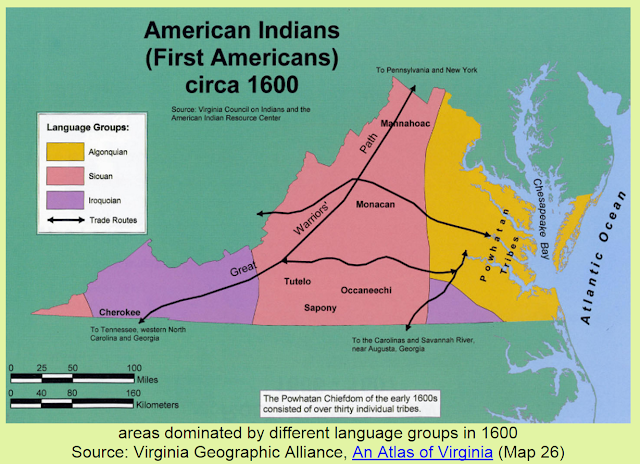Learning Facts by Testing
Knowledge is built on learning facts. Even in chemistry, the fact that atoms in the gas phase can produce a line spectrum is the first step in understanding the electronic structure of atoms. Understanding history, without any doubt, hinges on learning facts. Even with Google, one could not really find pertinent information without knowledge of the correct keywords to use. Basic education therefore can not do without building a child's memory.
My son, who is in fourth grade, is currently being introduced to Virginia's history. This week's topic covers the various Native American tribes of Virginia. Right at the beginning, the challenge is obvious. The names of the tribes and the languages used look really foreign to both of us.
 |
| Above copied from VirginiaPlaces.org |
The major tribes are: (1) Cherokee, who lived in the southwestern region of the state and spoke Iroquoian, (2) Monacan, who lived in the Piedmont region (central part of Virginia) and spoke Siouan, and (3) Powhatan, who lived in the tidewater or coastal plain and spoke Algonquian. The map above is colorful enough that it might just get my son's attention. Perhaps, I should also mention that Pocahontas belongs to the Powhatan tribe as that might just pique my son's interest.
A child can read and reread a piece of text to memorize facts. My son can stare at the above map. Such activities sadly are not really that inviting. Using a test to improve memory has been recommended by cognitive and educational psychologists. The pupils in a classroom can be divided into pairs, and within each pair, students can quiz each other.
There are sites online that can provide test enhanced learning. And for the topics covered in Virginia Standards of Learning in Social Studies, such sites have been collated. The page for my son's current lesson can be found through this link.
Here are the quizzes, exercises, or tests (the site calls these games) that one can reach through the links provided. The first one is a "fill in the blanks" exercise. This is actually a multiple-choice activity since for each blank there is a drop down menu from which a child can choose his or her answer.
|
| ||
| ||
Then, my son went to the Millionaire game. This is a multiple choice test.
 |
| Above copied from Quia |
When he reached the end, he wished he was really winning a million dollars. Then, he tried a crossword puzzle. And he was able to complete the puzzle.
 |
| Above copied from Salem City Schools |
Lastly, I guessed the site saved the best at the end. My son got a chance to Fling the Teacher:
 |
| Above copied from Suffolk Teaching and Activities Resources (STAR) |
Whether the above activities would help my son remains to be seen, but research in education provides a clear answer to this question. For instance, in a paper scheduled to be published in the Journal of Educational Psychology, it is shown that testing improves fact retention by about 40 percent (compared to rereading or restudying). The study includes fifty undergraduate students and representative results are shown below:
 |
| Above copied from Testing With Feedback Yields Potent, but Piecewise, Learning of History and Biology Facts. Pan, Steven C.; Gopal, Arpita; Rickard, Timothy C. Journal of Educational Psychology, Oct 12 , 2015, No Pagination Specified. http://dx.doi.org/10.1037/edu0000074 |


Comments
Post a Comment